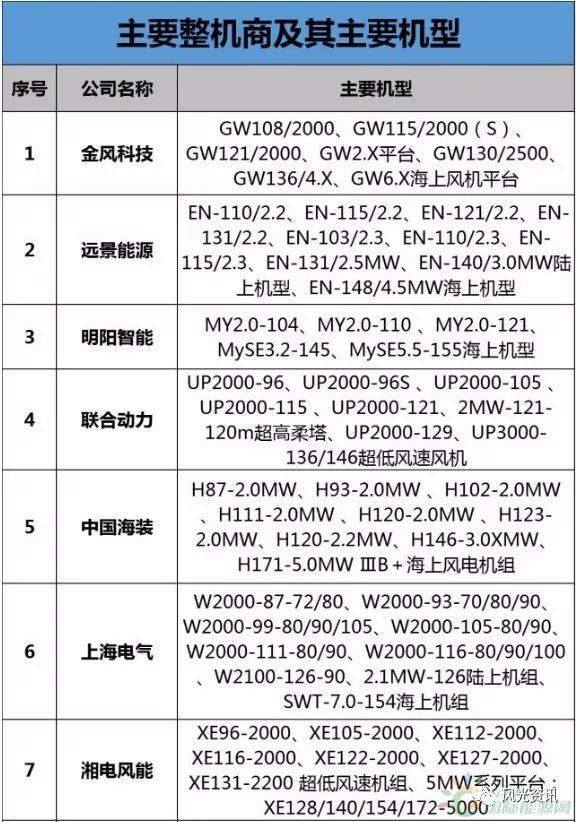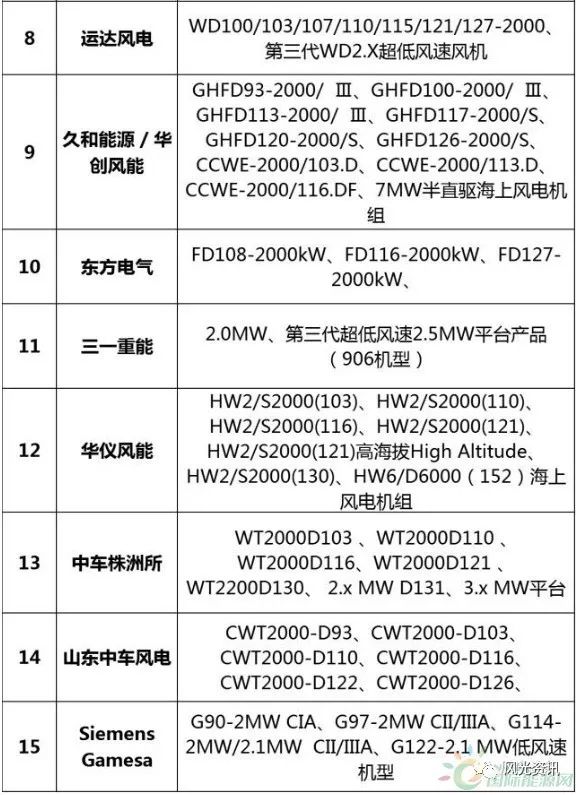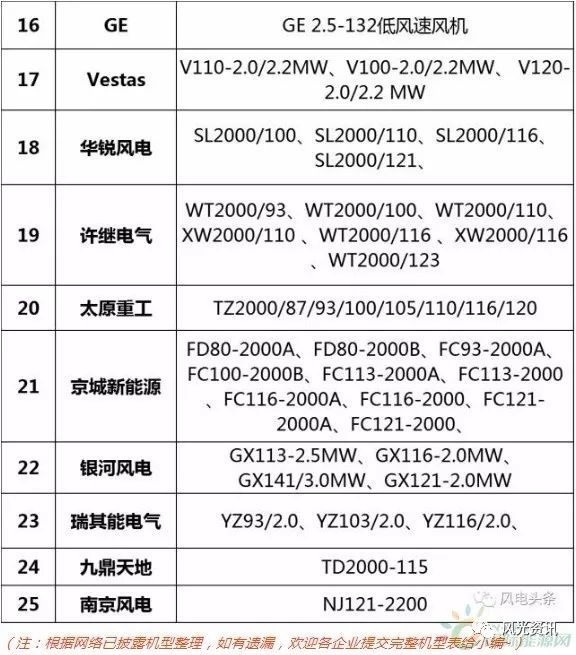The correct unit selection is the key point and key of wind farm design. The correctness of wind turbine selection directly affects the safety and economic benefits of long-term operation of wind farms.
"Wind Power Unit" selection strategy, what are the precautions? The most complete unit styling list in history!
The factors determining the profit level of wind power projects include wind resource status, grid access status, on-grid price, unit selection and operation and maintenance level. After the project is approved, the first three items are basically a foregone conclusion, and the importance of unit selection is obvious.
The correct unit selection is the key point and key of wind farm design. The correctness of wind turbine selection directly affects the safety and economic benefits of long-term operation of wind farms.
What is the unit selection?In the process of building a wind farm, the choice of wind turbines is subject to conditions such as natural environment, transportation, and hoisting.
At the same time, the choice of wind turbines determines the investment and power generation of the construction site. The selection of the wind turbine is to choose the best fit between the two.
Under the premise of advanced technology and reliable operation, according to the wind energy resources of the wind farm, select economically feasible wind turbines, calculate the annual power generation of the wind farm, and select the wind turbine with the best comprehensive index.
The selection of wind turbines not only affects the investment in wind farms, but also affects the amount of power generation and operating costs after commissioning, and ultimately affects the on-grid price.
Basic principles of unit selectionThe premise of unit selection is that the project is profitable. The higher the electricity price, the better the wind resources and the higher the profitability of the project. So what are the basic principles to be followed in fan selection?
First of all, the performance price ratio is optimal, that is, the wind turbine generator with the best performance and quality is purchased at the lowest price.
Secondly, taking the minimum power generation cost as an indicator, fully consider the benefits of generator input and output. In some special cases, if the power generation of each wind turbine is not much different, then the wind turbine should be selected to consider whether it can be converted to the maximum capacity factor with the minimum power generation cost.
Influencing factorWind turbine safety
Different wind farm conditions have different external conditions such as wind conditions and climatic factors. Therefore, wind turbines have different design requirements and corresponding safety levels according to different site conditions. Table 1 is the IEC61400-1 (third edition) wind turbine rating table.
Table 1 Wind turbine rating table

In the above table, all parameter values ​​refer to the parameters at the hub height:
Vref - reference wind speed (10min average);
A - higher turbulence intensity level;
B - medium turbulence intensity rating;
C - lower turbulence intensity level;
Iref-turbulence intensity at a wind speed of 15 m/s.
The maximum wind speed and turbulence intensity in 50 years is the two most basic indicators for the selection of the unit. After the position of the wind turbine in the wind farm is determined, according to the relevant standards, the wind conditions of each wind turbine need to be carried out. Safety assessment, the assessed wind resource parameters are:
(1) Maximum wind speed (10 min) and extreme wind speed (3 s) at 50-year height at each hub height;
(2) Effective turbulence intensity at the height of each hub (the superposition of turbulence intensity between the ambient turbulence intensity and the wake between the aircraft positions);
(3) The wind speed distribution probability density between 0.2Vref and 0.4Vref is less than the wind turbine design value;
(4) Inflow angle (the angle between the inflow airflow and the horizontal plane is ≤ 8°);
(5) Wind shear coefficient 0.05
(6) When the distance of the main wind direction is more than 5 rows or the vertical main wind direction is less than 3D (D is the diameter of the wind turbine impeller), the ambient turbulence intensity of the wind farm is increased, which ultimately affects the effective turbulence intensity of the aircraft.
Economics of wind turbines:
The economics of wind turbine selection mainly refers to the evaluation of the economic benefits generated by the investment in the wind farm. For a wind power project, the main risk variables are fixed asset investment, annual on-grid electricity and on-grid electricity prices. In the case that the grid price is temporarily uncertain, due to the large fluctuations in wind turbine equipment prices, the wind power project investment return problem has become a major factor affecting wind power project investment. Therefore, in the case of grid price given, for the construction and investment of a wind farm, it is necessary to consider the cost of the unit kilowatt, the annual on-grid power generation and the internal rate of capital. Through the calculation, comparison and analysis of various schemes for wind farm construction, economic indicators that reflect each scheme are obtained.
The economics of the unit is mainly considered from the aspects of wind farm investment and power generation.
Under the condition that the total installed capacity of the wind farm is fixed, from the economic point of view, the comprehensive cost of large-scale wind turbines, especially those above MW, is lower.
From a technical point of view, the generator of the wind turbine generator gradually develops from the induction generator running at constant speed to the generator with variable speed operation using high wind energy utilization; the power control is gradually developed by the fixed pitch stall type and the active stall type. To pitch power control. In the selection of models, priority should be given to large-scale advanced wind turbines with low cost, advanced technology, high utilization of wind energy and wide application.
Technical selection of wind turbines
The technical characteristics of wind turbine selection are mainly reflected in the following aspects: wind resource assessment; wind power calculation; on-grid electricity estimation; unit reliability.
1 Wind resource assessment
Wind farm construction, first of all, the wind resource assessment of the selected wind farm. At present, many testing equipment and evaluation software have been developed for testing and evaluation of wind resources at home and abroad. Commercial software has been developed for wind farm site selection, especially for micro-site selection, such as WASP, a resource analysis tool developed for the micro-location of wind farms developed by the Danish RIS National Research Laboratory; meteodyn WT developed by France Medic Wait. There are similar softwares in China, such as the electric field design and optimization software WINDFARMER, which makes the wind resources have certain guarantees during the evaluation, which provides an important basis for the selection of the next-machine capacity.
2 wind power calculation
According to the conclusion of wind resource assessment, determine the annual average wind speed and annual wind power density of the wind farm, and further determine whether the wind direction of the wind farm is stable, whether the turbulence intensity is small, and the measured air density and wind shear index and wind power density in the field. Wait. According to the Wind Power Resource Assessment Method for Wind Power Plants (GB/T18710-2002), it is qualitative to determine which type of wind field the wind farm belongs to, so that high-efficiency wind turbines suitable for the wind farm are selected for wind turbine selection.
3 estimation of online electricity
According to several types of models suitable for the wind farm, the calculation of the annual theoretical power generation is also required. That is, according to the power and thrust coefficient curves of the wind field in the standard state, the arrangement of the wind turbine and the topographic map of the wind farm, the theoretical power generation in the standard state is calculated by a program. Then consider the air density correction, wake correction, control and turbulence reduction, blade pollution reduction, power curve reduction, plant power, line loss and other energy losses and climate impact shutdown, etc., estimate the wind farm engineering year Internet power.
4 unit reliability
The reliability of the unit refers to the reliability of the stable operation of the unit considering the structure and composition of different models. In addition, reliability is also related to the quality, production quality and installation quality of the components selected for the unit.
Practicality of wind turbine selection
The practicality of wind turbine selection mainly refers to the constraints of the wind farm's natural conditions, transportation, and hoisting according to the characteristics of the wind farm. At the same time, we must also consider the overall planning and scale of the wind farm, combined with the technical nature of the selection, and thus decide to use a practical type of unit.
Wind turbine selectionThe selection of wind turbines is divided into single capacity selection and model selection:
1, single machine capacity selection
According to the current status of the domestic and international wind turbine market and the installed capacity of domestic wind farms, the fans can be divided into four levels according to the capacity of the single machine.
1600kW class unit: 600kW or 750kW single unit, suitable for installation in wind farms with complex terrain. Such foreign units have begun to exit the wind turbine market. The domestic manufacturers of this level of wind turbines include Xinjiang Goldwind and Zhejiang Yunda.
2850kW class unit. The single unit capacity is between 850 kW and 1000 kW. These units are mature in technology and have good operating performance. They are suitable for wind farms with poor site conditions and difficult transportation. There is still room and potential in the market. This level of wind turbines is installed in large numbers in the country.
3MW class unit. The unit capacity is between 1MW and 3MW. These units are relatively mature in technology. At present, China's 1.5~2MW units have become mainstream mature models, and 3MW units have achieved mass production. The performance has grown rapidly. Stepping up the pace of launching 5MW and 6MW models, the prototypes of Huarui, Mingyang and Guodian combined power 6MW models have been installed, and Huarui, Xiangdian, and Haizhuang have installed 5MW prototypes, which will gradually accumulate practical experience and step into batch production. Production stage.
4 multi-MW class units. The components of this type of fan are ultra-long, overweight, and difficult to transport and hoist. Currently, there are a certain number of installations in developed countries such as Europe and the United States, mainly installed in offshore wind farms, and have not been put into commercial operation on a large scale.
2, the choice of model
In the field of wind power technology, the types of fans are mainly differentiated according to their different adjustment technologies. In the current fan market, there are two main types: fixed pitch and variable pitch. The pitch adjustment technology mainly includes: slip, pitch, variable speed, frequency conversion and double feed. The fixed pitch fan has simple structure, simple adjustment mode, firm and firm structure, and is used by small and medium-sized units. It is suitable for installation in wind farms with relatively complicated wind conditions.
The pitch is lighter than the fixed pitch fan structure, and the structure is complicated. It can be adjusted according to the change of wind speed to obtain more power. Most of the MW-class units use pitch, variable speed, and doubly-fed technology. Each adjustment technology represents a different type of fan, and has its own characteristics, suitable for different wind farm conditions, there is no pure advantage.
At present, wind turbines are rapidly developing in the direction of large-scale and high-efficiency. After several decades of development, the grid-connected wind turbines have basically eliminated some models that are not practical, technically flawed or not of commercial value, forming the most common horizontal axis, 3-blade, upwind, and tubular The unified mode of the tower.
The selection of the unit is based on local conditions.
There are many different topography on 9.6 million square kilometers of land in China. What kind of wind resources, geographical features and development environment determine what kind of models are used by development companies. At this time, we need to choose according to local conditions. Feng Ge mainly sorted out the “Three North†areas in China; the selection of wind turbines in low wind speed areas and offshore wind power:
01. “Three North†area and the central and eastern plain areas:
The development enterprise adopts a model with a large single-unit capacity, which is more in line with the law of regional wind power development. The reasons are as follows:
1, "large capacity" models can effectively reduce wind power development costs.
First of all, China's "Three North" region and the central and eastern plains are flat and the project construction is difficult. There is no need to invest in a large number of road reconstruction and hoisting platform construction costs, which facilitates the transportation and hoisting of "large capacity" models.
Secondly, the use of "large capacity" models can effectively reduce the number of units installed and save investment costs in the early stage of the project. For example, in a project with a total capacity of 100,000 kilowatts, the model with a single unit capacity of 3.4 MW is 25% and 40% lower than the 2MW model in terms of total base cost, total hoisting cost, and total floor space. , 17% or more.
Thirdly, due to the smaller number of units, the 3.4MW model is easier to optimize the wind farm than the 2MW model, thus reducing the wake impact of 2% to 3% in different projects and effectively improving the overall power generation capacity of the wind farm. .
2. The large-capacity model is conducive to the intensive development of wind power land.
The central and eastern regions of China are densely populated, economically developed, and the cost of land acquisition is high.
Therefore, the use of “large capacity†models in the central and eastern plains can avoid the problem of insufficient machine sites and the inability to achieve the total capacity of the project development; on the other hand, if the number of aircraft sites is sufficient, further Optimize the point design to improve the power generation capacity of the wind farm.
02, low wind speed mountain area:
The low wind speed area is more suitable for the "small capacity + large impeller" model with a single unit capacity of 2MW. It can reduce the difficulty and cost of transportation and lifting in mountainous areas, and fully utilize the low wind speed power generation capacity of the unit to improve project revenue.
03. Offshore wind farm wind turbine selection:
The main method for the selection of offshore wind turbines is to determine the recommended models by comparing the technical and economical aspects of the primary wind turbines.
Economic efficiency is mainly measured by the quantitative indicator of electricity cost;
The technical consideration mainly considers the manufacturing level, technical maturity, product reliability and ease of operation and maintenance of wind turbines. It is more qualitatively compared and lacks strong persuasiveness;
In addition, the lack of operational and maintenance costs in the economic comparison.
With the main machine model



SHENZHEN CHONDEKUAI TECHNOLOGY CO.LTD , https://www.szfourinone.com